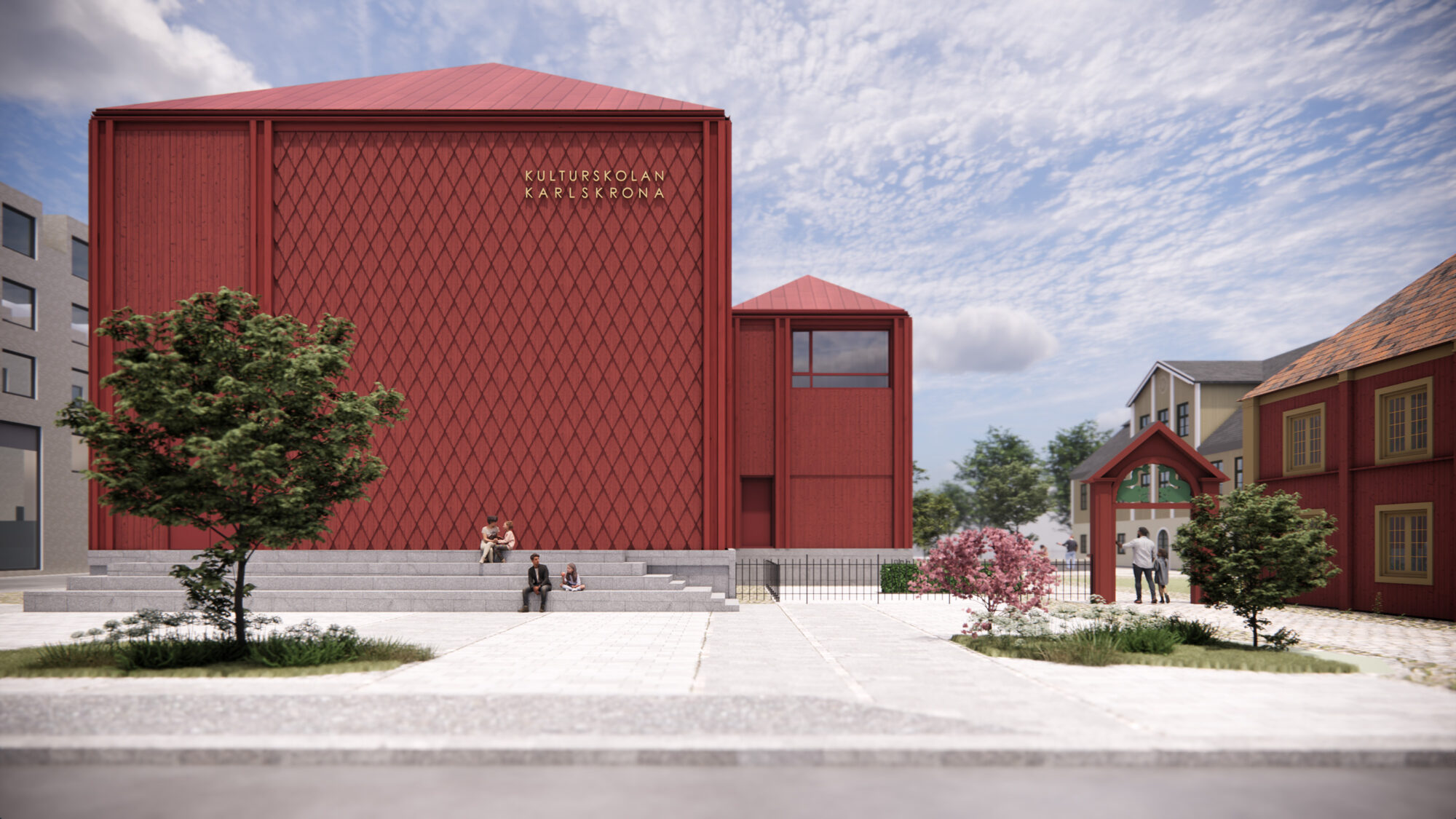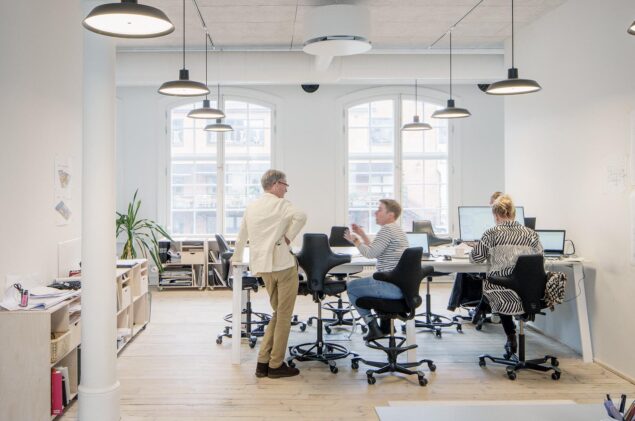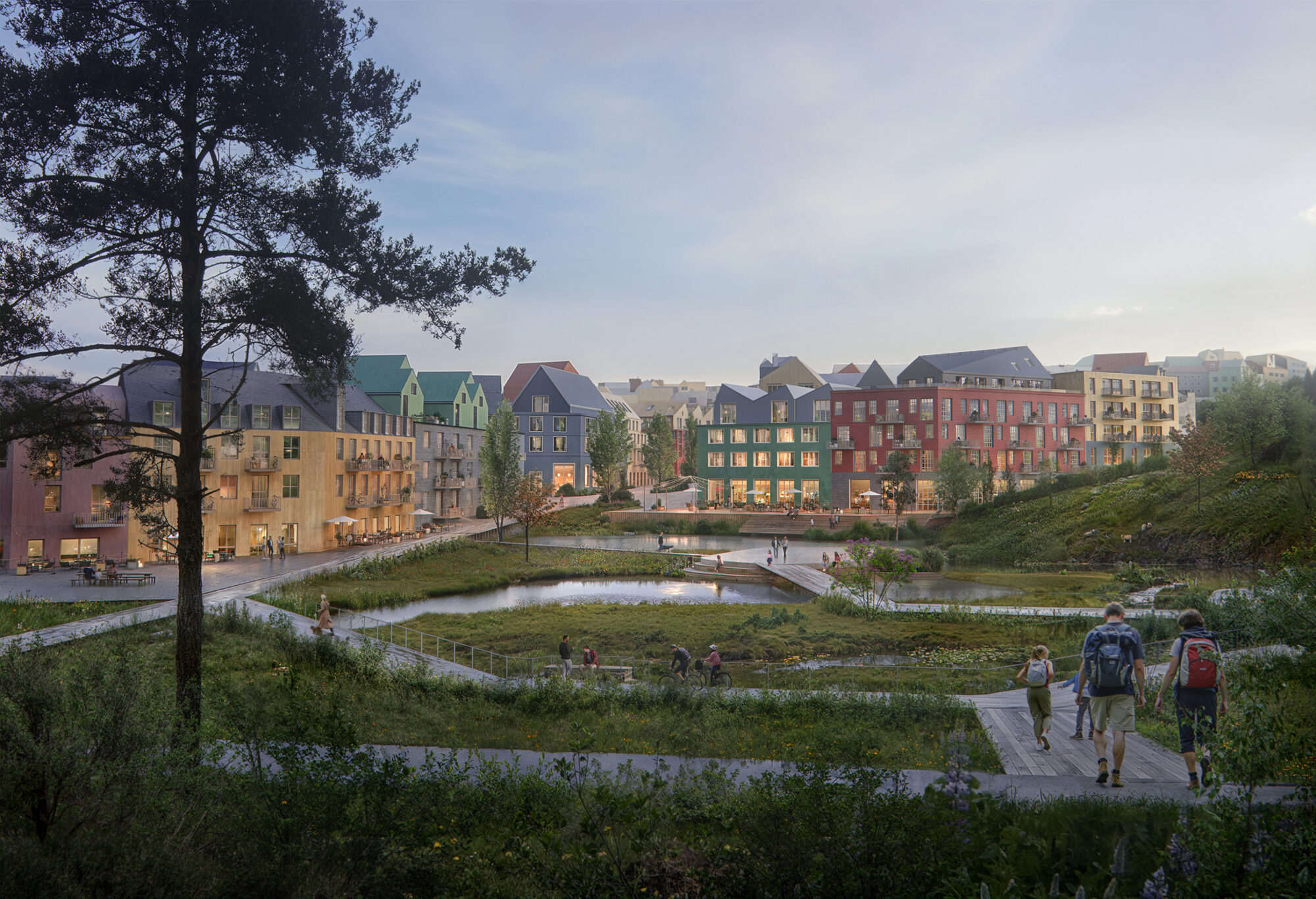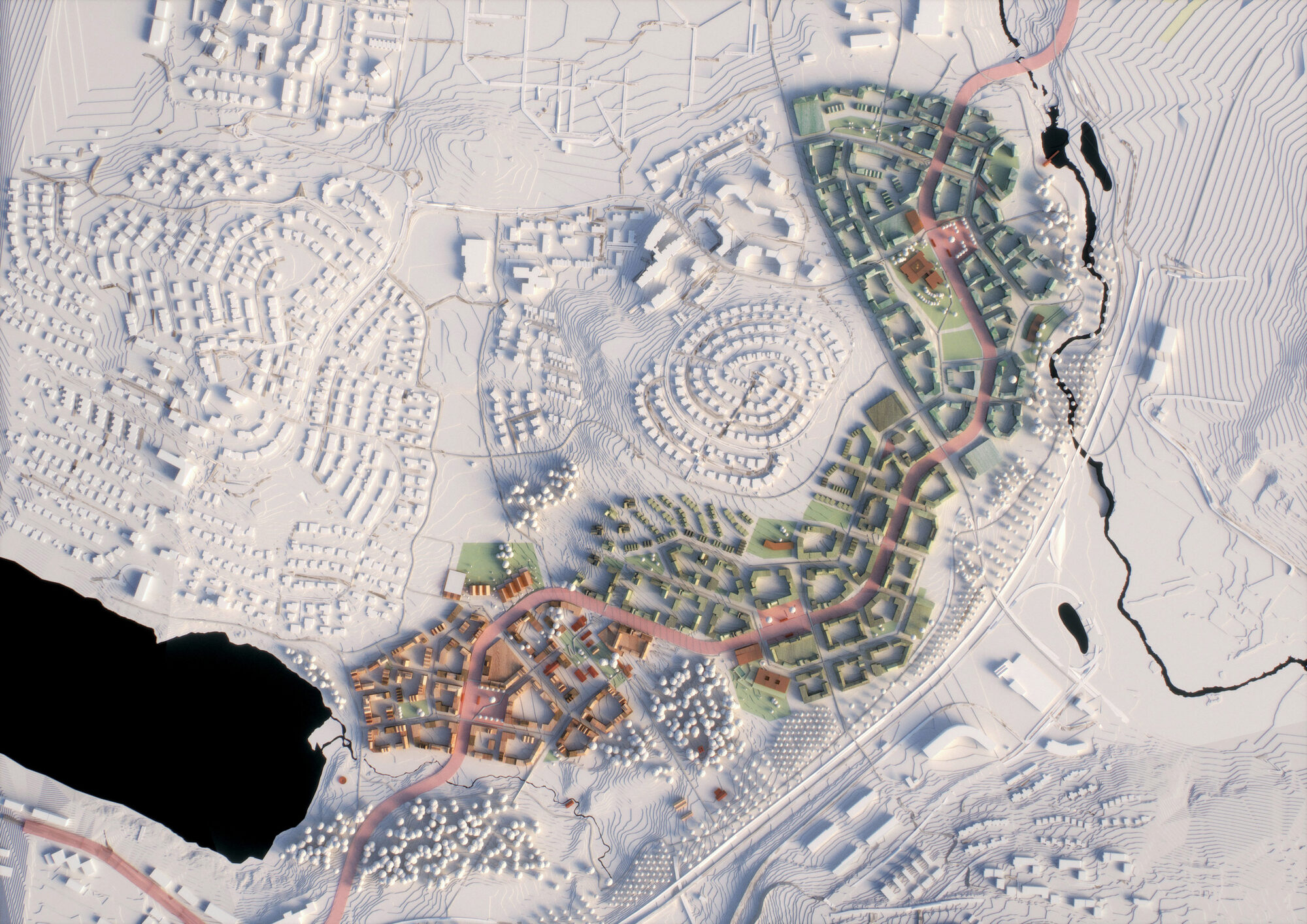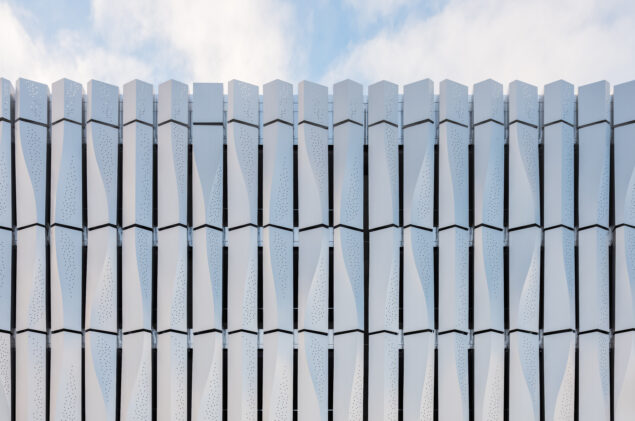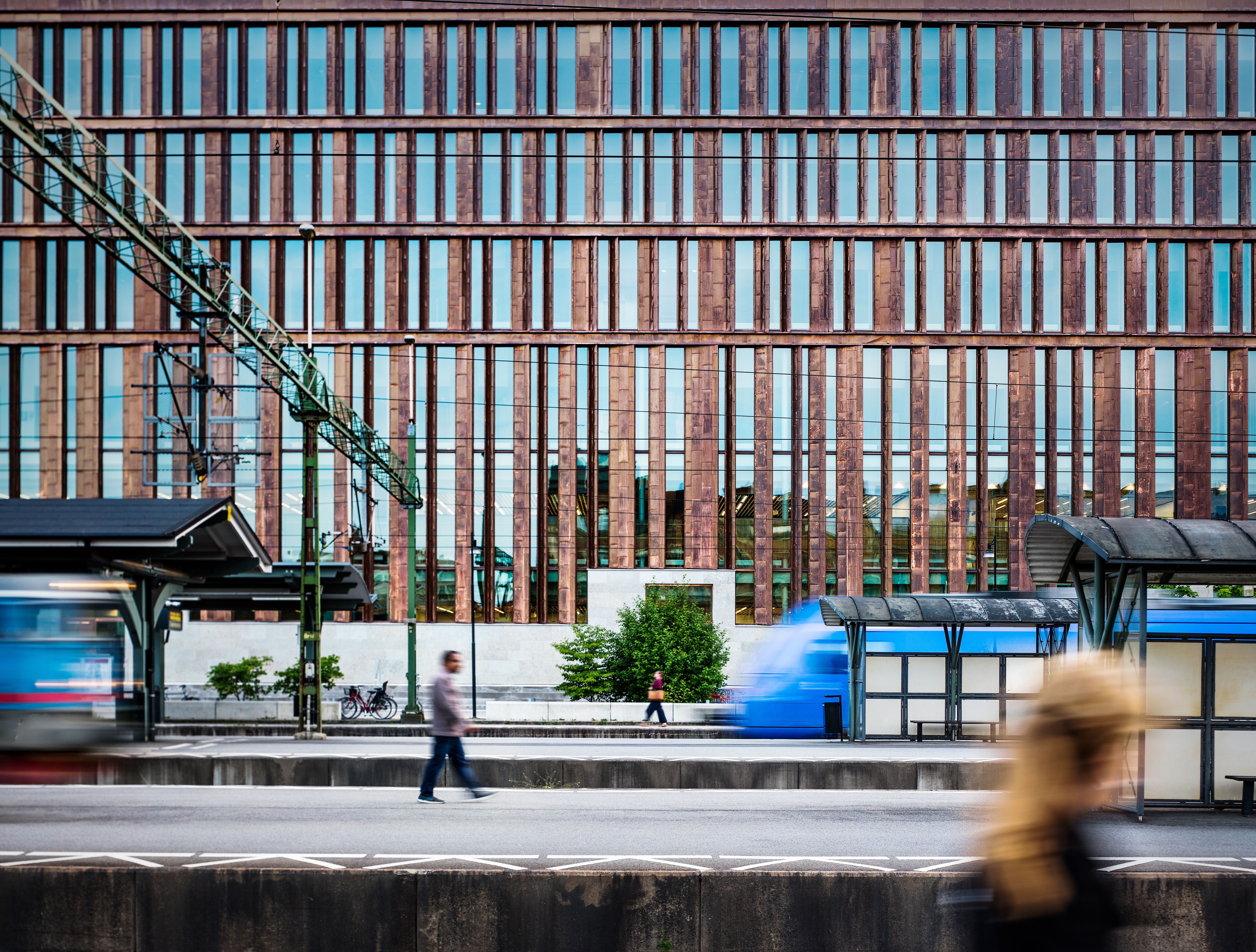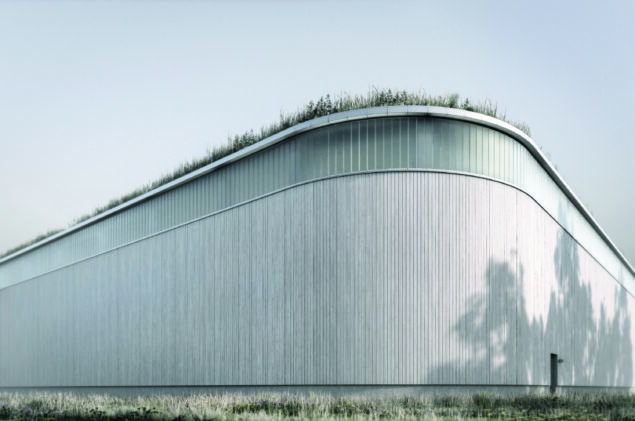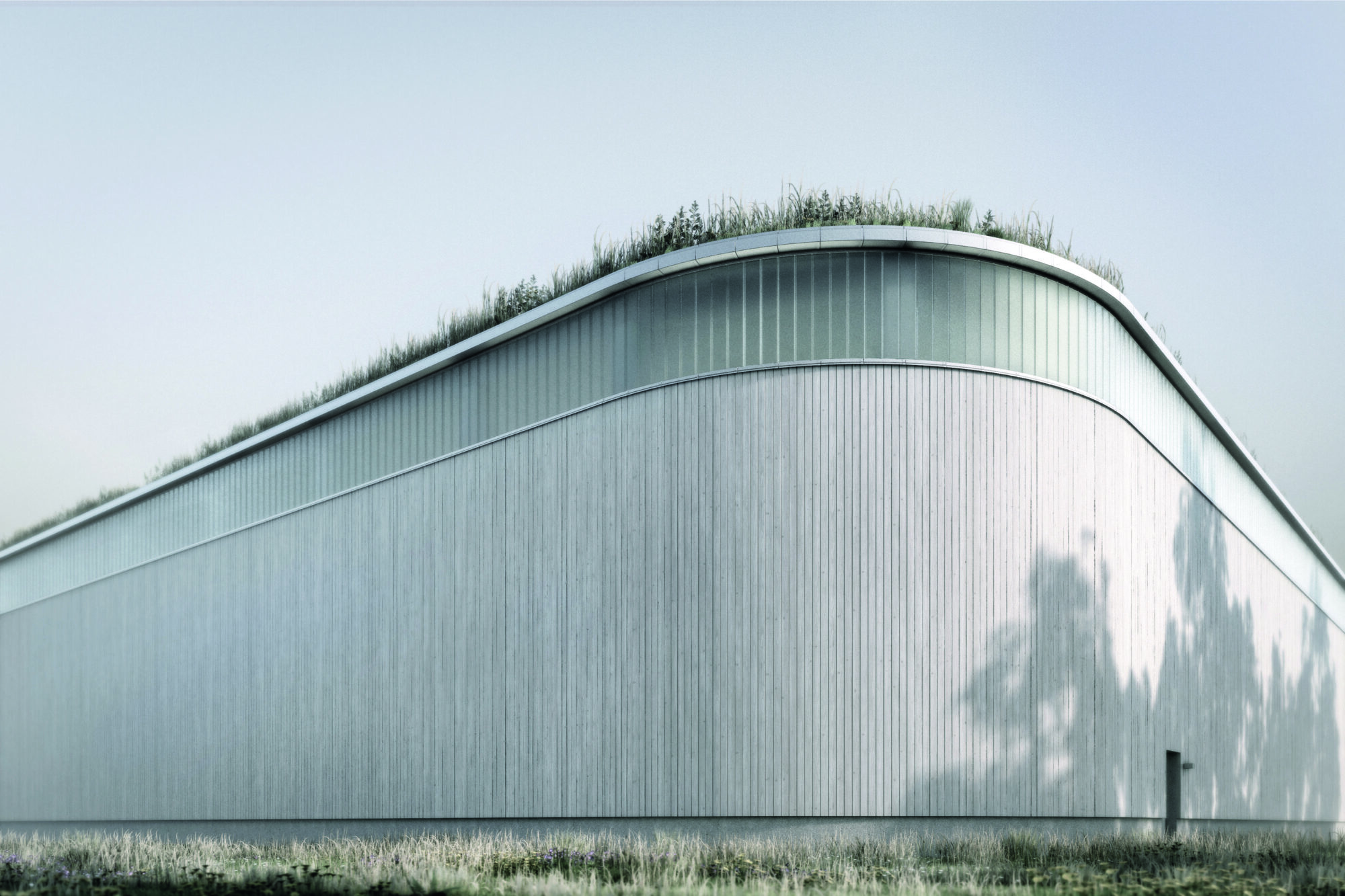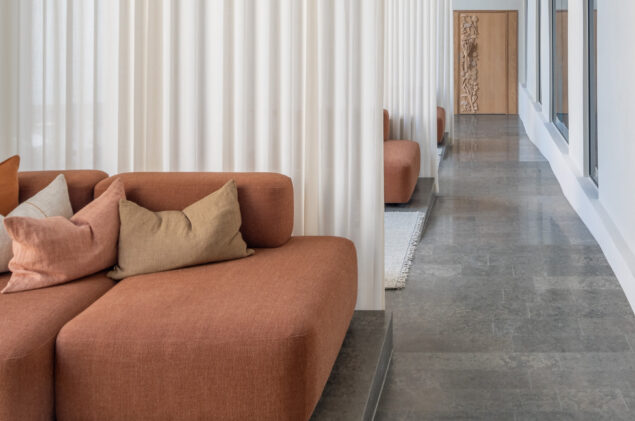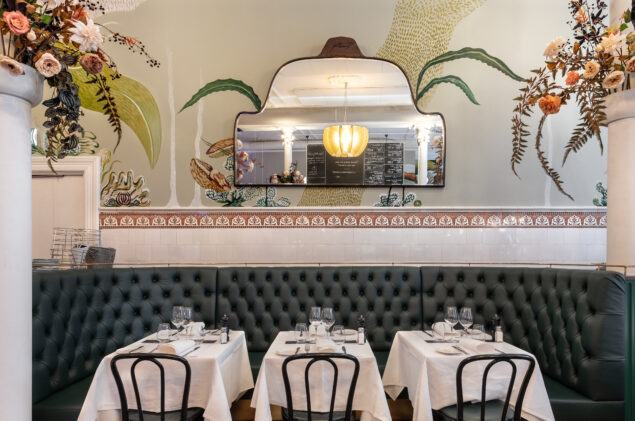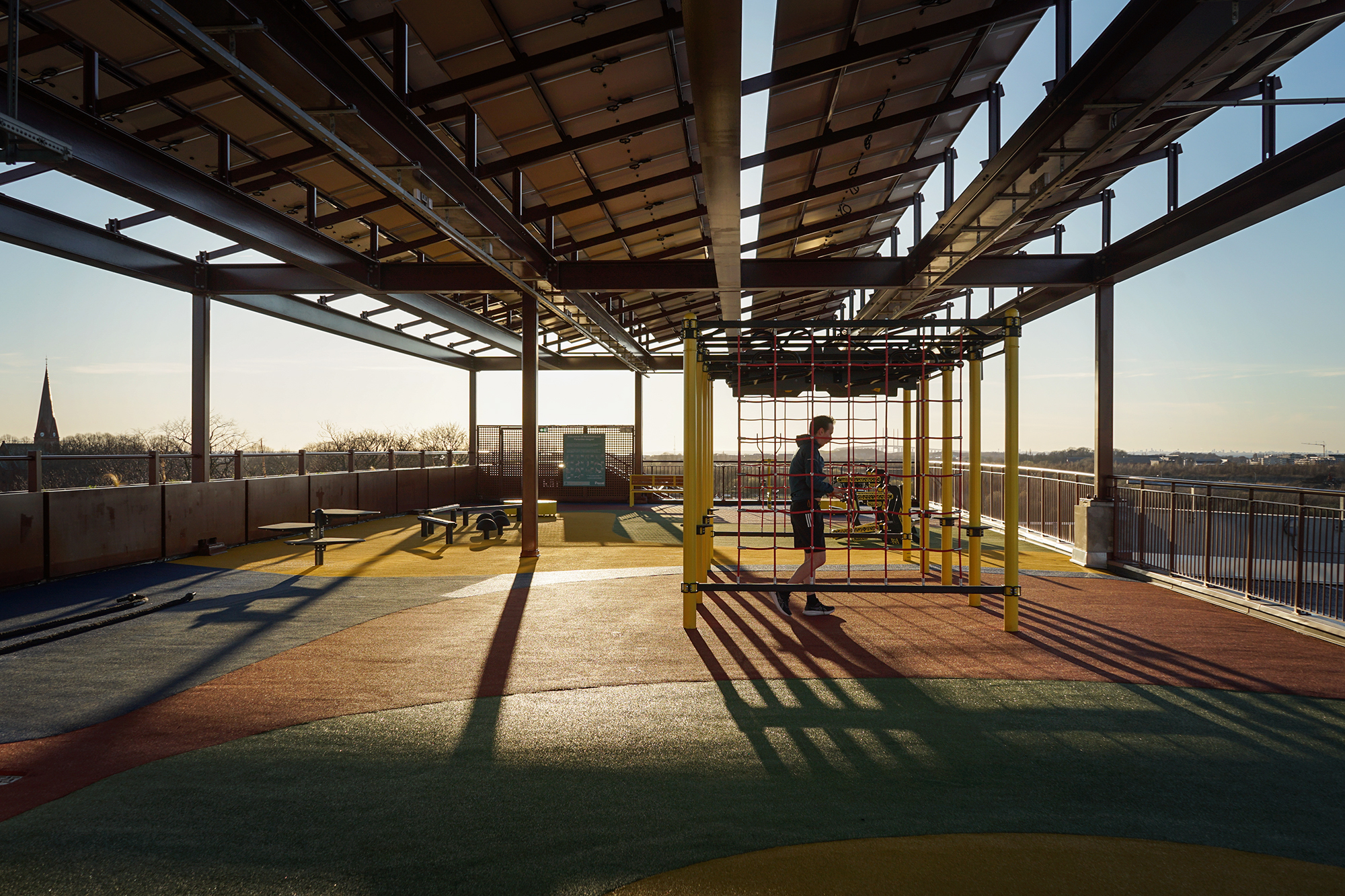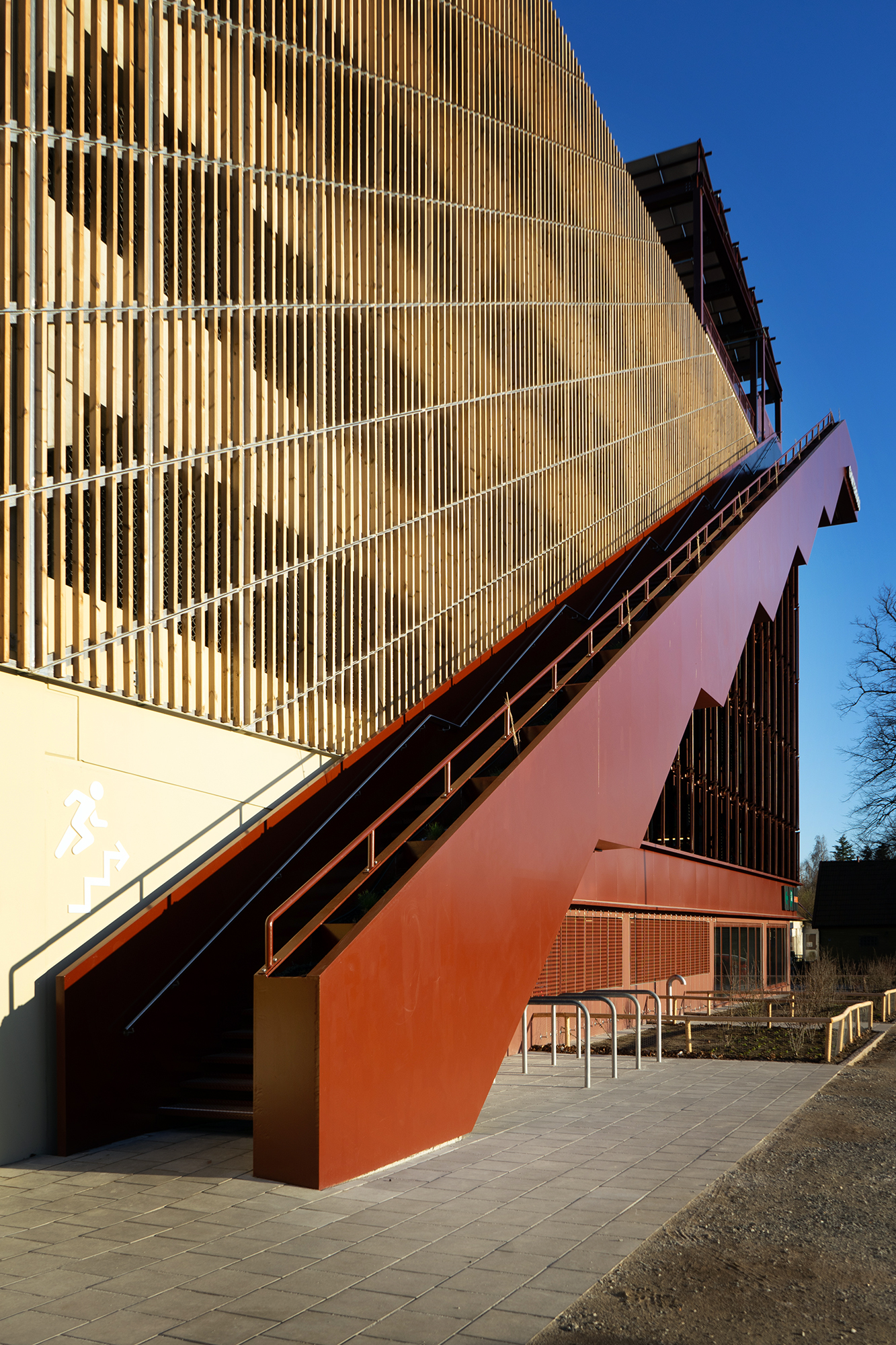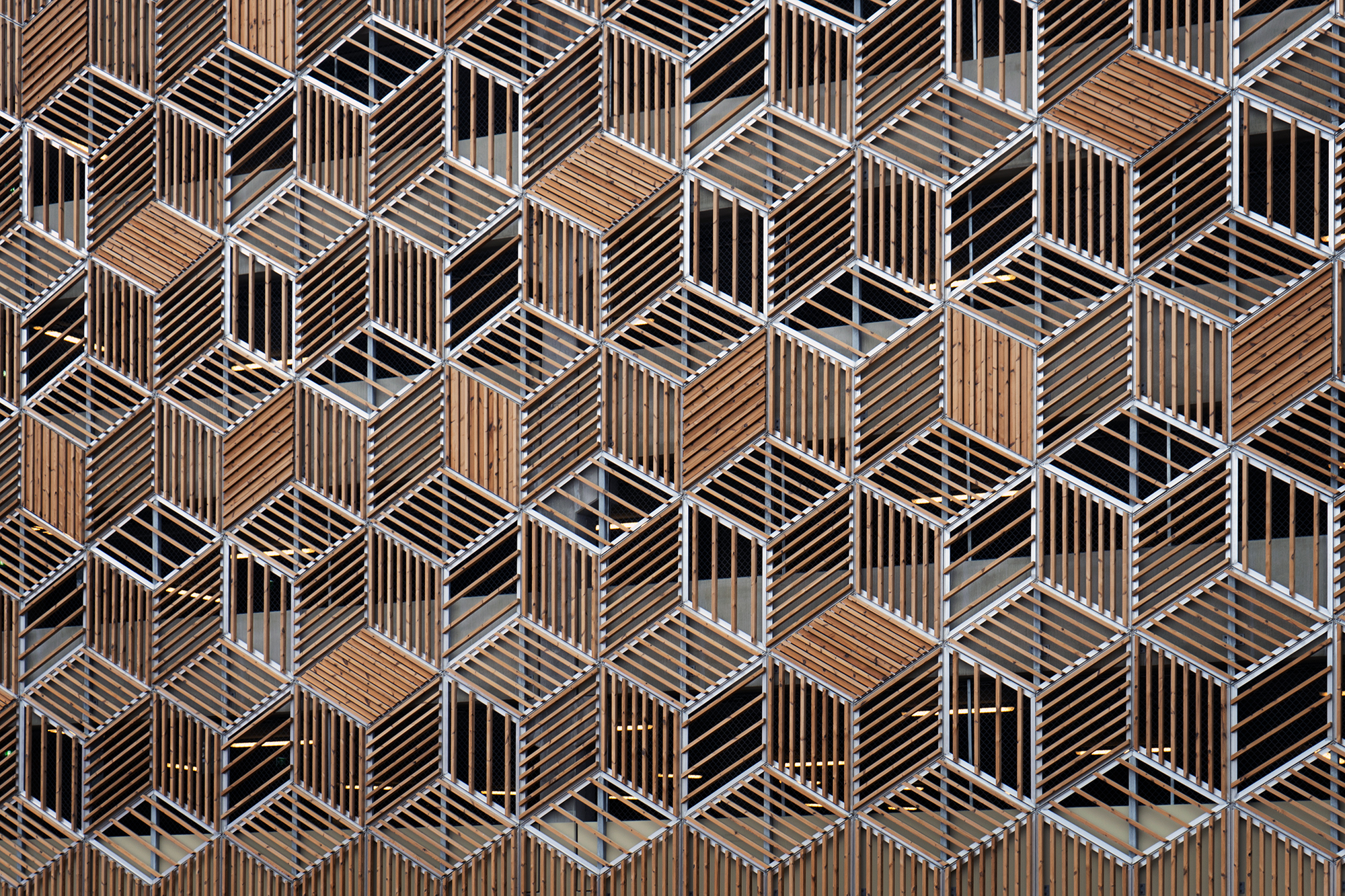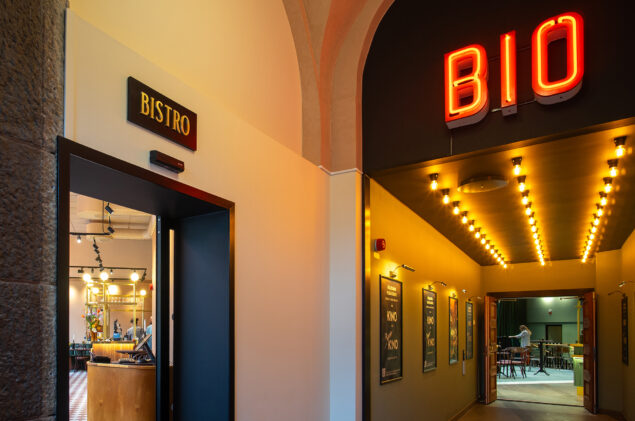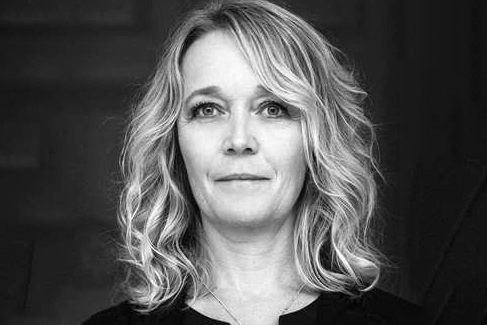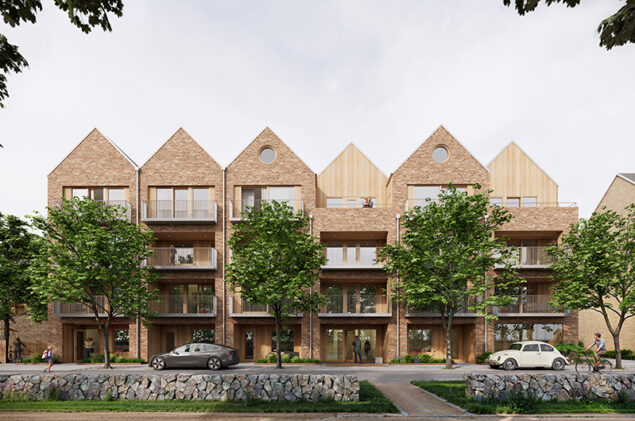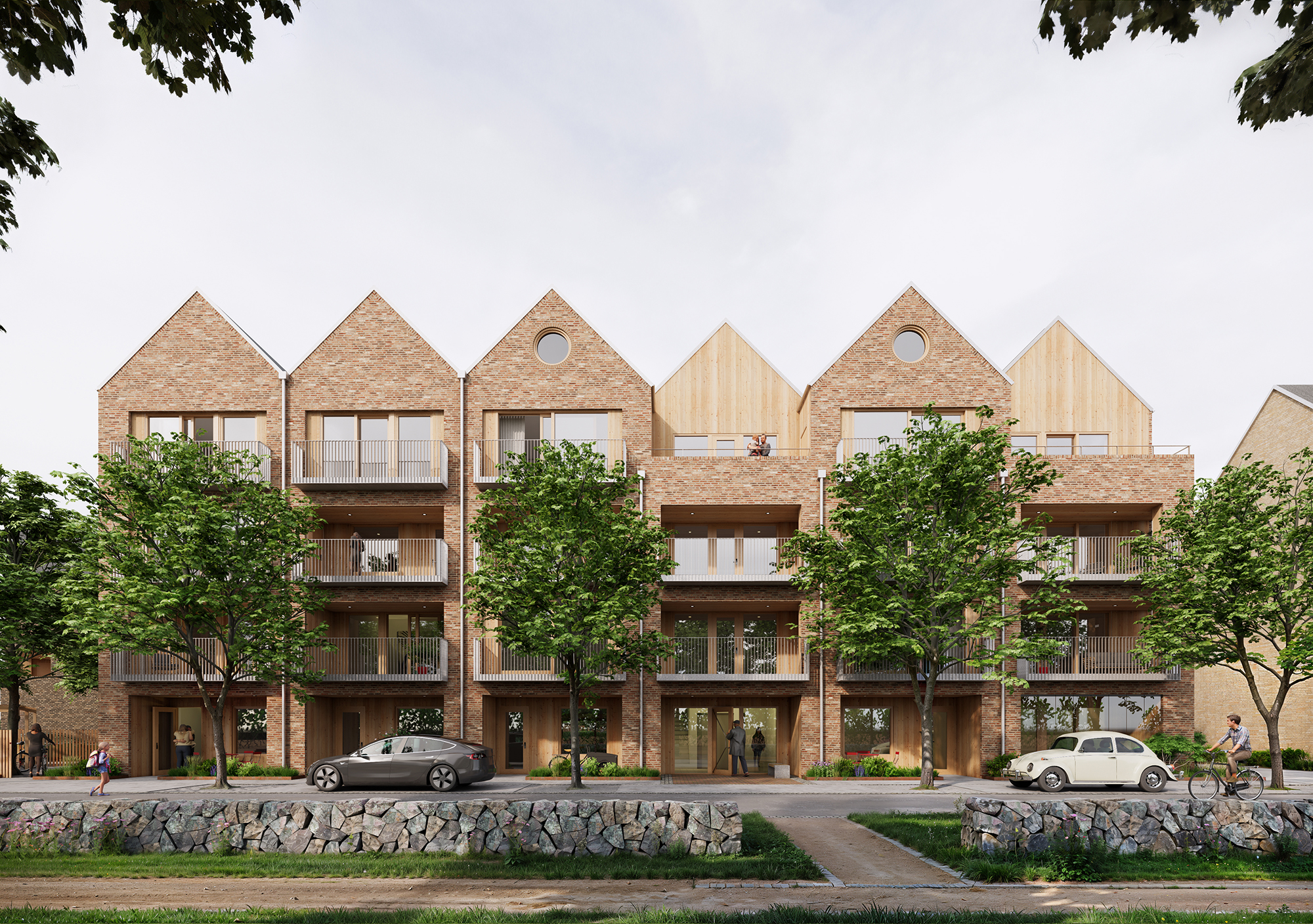2025-10-09
Imaginative dolphins show the way to Karlskrona's cultural school
An old wooden gate with scaly dolphins leads into Karlskrona's new cultural school and the wonderful world of culture. Construction of the school designed by FOJAB is now nearing completion.
- "Culture is a gateway to the outside world and unique experiences. The design of the new cultural school aims to meet and activate the city, to let the journey and adventure of culture take place in the varied urban spaces that the new buildings create, says Stefan Johansson, responsible architect at FOJAB.
The new building will replace the current premises which are not fit for purpose. The new school will include halls for choir, orchestra, dance and theater, a recording studio, classrooms, ensemble rooms, staff rooms and recreation rooms. FOJAB won the design assignment together with acoustic consultants Brekke & Strand and is also responsible for the design of the outdoor environment.
The school is being built in a sensitive cultural environment in the part of Karlskrona that is a UNESCO World Heritage Site. The new building fits into the urban fabric and forms an ensemble with an office building and an 18th-century farm, Palanderska gården, which will be converted to also become part of the cultural school. The older layers also include the imaginative Dolphin Gate.
The material palette is drawn from buildings in the immediate vicinity of the school that are typical of the site: fake red wood, granite and sheet metal.
The school building is designed as four clearly legible volumes that vary in scale, height and width. A fifth 'space' is created between the volumes - a magical courtyard for play and fun, but also for teaching and events.
To the south, a new city square is created, the entrance square of the cultural school. Here, the base of the building will become a welcoming staircase where you can sit down in the sun. It can also serve as a stage for various types of performances. The square is delimited by sunken rain beds in the form of an island landscape and with materials that allude to the archipelago landscape just outside.
Construction is planned to start this fall/winter.
2025-09-09
FOJAB has been ISO certified for quality and environment
FOJAB is now certified according to ISO 9001 (quality) and ISO 14001 (environment). "For our customers, it means extra security that we work professionally and long-term", says Joanna Attvall, architect and quality and environmental manager at FOJAB.
ISO certification is proof that management systems and working methods meet international requirements for structure, quality and sustainability.
FOJAB's systematic sustainability work was particularly highlighted as positive in the external audit, such as its own ART determination method. It is used to identify significant environmental aspects and assess the sustainability potential of each individual assignment. The results then form the basis for target setting, decision-making and evaluation.
The goal of ISO is continuous improvement. The certification supports continuous development and the delivery of sustainable architecture with high quality and relevance.
- With clear processes in place, we free up time and energy for what is value-creating, innovative and fun: to think new, be creative and create architecture that surprises and lasts in the long run," says Joanna Attvall.
2025-09-01
Erséus Arkitekter joins FOJAB
On September 1, Erséus Arkitekter will become part of FOJAB's office in Gothenburg. "This will be a dream team for our customers in western Sweden," say FOJAB's CEO Daniel Nord and Peter Erséus, founder of Erséus Arkitekter.
To best meet the needs of clients, Gothenburg-based Erséus Arkitekter has chosen to join FOJAB. The two offices complement each other well and are united in their view of architecture, focus on quality and value creation.
Erséus' strong roots in the local market and FOJAB's expertise will be a great asset in the continued development of the joint Gothenburg office. The merger means completely new opportunities to take on assignments in order to contribute to the development of an exciting region with combined creativity, competence and innovative power, increased presence and more resources.
- The fact that Erséus chooses to join us at FOJAB feels honorable and will be an important step in strengthening our position and our offer to our clients in western Sweden, says Daniel Nord, CEO of FOJAB.
- We have followed FOJAB's development and identified our great similarities in values, and now we look forward to developing further as part of FOJAB and meeting the future with continued focus on our customers' needs, says Peter Erséus, founder of Erséus Arkitekter.
FOJAB is one of Sweden's leading architectural firms with a total of approximately 170 employees in Malmö, Stockholm, Gothenburg and Helsingborg. The assignments include architecture at all scales - investigation, planning and design of urban environments, buildings, landscapes and interiors. The company is owned by leading architects. FOJAB has designed rental apartments at Uggleberget in Nya Hovås, the Argus cultural center in Falkenberg and the urban development program for the Centralen area in Gothenburg. A current project is housing at Masthuggskajen.
Erséus Arkitekter, with offices at Skeppsbron in Gothenburg, employs ten people. The office works with urban development, housing, hotels, offices, public buildings, cultural properties and more. Completed projects include Gothenburg City Library, Hotel Draken, Angered Arena, Kviberg Crematorium and a large number of housing projects. Several projects have won awards for their architecture.
Please contact
Daniel Nord tel 0706 87 88 82
Peter Erséus tel 0705 94 45 53
2025-08-25
More nature and less carbon footprint in Reykjavik's most sustainable district
The Keldur district in Reykjavik will become a model for Icelandic urban development and is an important piece of the puzzle on the road to climate neutrality. FOJAB has developed the basis for the in-depth master plan, which is now out for consultation.
Two years ago, the City of Reykjavik launched an open international competition for the development of the Keldur district for 12 000 inhabitants. The city's ambitions were high: the new district should focus on sustainable mobility, social sustainability and structures for water and greenery. FOJAB won the competition with a proposal based on a social mix in a dense and flexible urban structure along a new rapid transit line and close to nature.
FOJAB then developed the ideas further in collaboration with Ramboll, Efla, the City of Reykjavik and Transport of the Capital Area. Input from city administrations and other stakeholders has been incorporated and a development plan and design manual produced. This work forms the basis for the proposed in-depth master plan, which is now out for consultation, with Reykjavik residents invited to an open house.
The new district will be characterized by quality of life, child-friendliness, simple and easy everyday life in green, beautiful environments. Great importance is attached to preserving the natural qualities of the area, and nature has also been given more space than recommended in the master plan. The urban area has been reduced by 28 hectares, resulting in denser development and a lower carbon footprint. The Borgarlína express bus line connecting Keldur to the city center has been partially re-routed to better follow the landscape compared to an earlier proposal.
For FOJAB's part, work will continue to process the proposal once the comments from the consultation have been received. The detailed general plan is expected to be adopted in early 2026, after which work on detailed plans will begin. The expansion will take place in stages.
2025-08-11
"Mobility houses are perfect for testing innovative ideas"
The modern parking garage is so much more than parking: a tool to reduce car dependency, free up urban space and bring life to neighborhoods.
- Like a Kinder Egg with several solutions in one," says Anders Eriksson Modin, architect and head of the Mobility business area at FOJAB.
- From the 1960s onwards, society was planned to be easily accessible by car. At the same time, this has meant that large areas have been reserved for traffic, areas that could have been used for other things, such as more trees and plantings, playgrounds, outdoor seating, wider sidewalks and bicycle lanes. As cities in Sweden and around the world now demand more sustainable traffic solutions and quality urban environments, the mobility house is an important piece of the puzzle.
How do you do it? What exactly is a mobility garage, and how does it differ from a traditional parking garage?
- A mobility hub has many more qualities. First and foremost, it is a hub for different transport solutions: private and shared cars, bike parking and bike pool, micro-mobility in the form of electric scooters, charging infrastructure for electric vehicles. The idea is to offer smooth transitions between different sustainable modes of transportation so that private car use and fossil car dependency can be reduced. We see that mobility hubs can offer attractive alternatives to private car ownership and enable a simpler everyday life without compromising on quality and accessibility.
- Our ambition is also for the building to contribute to life in the city and its surroundings. The volume can be advantageously shaded with housing, preschool or offices. At FOJAB, we have designed mobility houses with, among other things, a grocery store, parcel delivery, gym, café. We also want to include vegetation and other ecosystem services that benefit biodiversity and strengthen the city's natural values.
International interest
Sweden's major municipalities are at the forefront of sustainable mobility. The view of the mobility house as an enabler is spreading to more cities - also internationally. FOJAB is currently working on a urban development projects in Iceland where an entirely new district is planned with a rapid bus line as the backbone of local public transport, providing the conditions for shorter commutes, simpler everyday life and improved quality of life. Here, the concept of the mobility house and how they are designed, programmed and placed has attracted great interest as part of the solution.
A parking revolution
Ever since the car became everybody's property, the question of how to solve the parking problem has been on the agenda. The answers have varied over the years. Anders calls the development a parking revolution.
- Underground parking was the prevailing solution for a long time, but it is increasingly being questioned. It costs a lot in both money and carbon. On-ground parking, on the other hand, takes up a huge amount of space - the average car is parked over 95% of the time. By consolidating parking in one place and sharing our vehicles, land can be used more efficiently. This frees up space that can be used to create great urban environments, more housing, more greenery.
Converting to housing
The next step in the parking evolution is mobility houses with the possibility of conversion, says Anders.
- When designing and building mobility buildings, we need to take into account that private car use may look different in the future. Attitudes to car ownership are changing and the need to own a car may decrease in the future. We don't want to build and then have to demolish, so we design for flexibility in the structure. If you remove the ramps between floors, a mobility building that is no longer needed can instead be transformed into housing or offices, using the existing frame.
What is it like to work on the shape and design of mobility houses?
- It's fun, a combination of efficient machinery and free rein design. First, you need a parking lot layout that makes the project economical, without compromising on comfort and safety. We at FOJAB are good at that. Once the parking solution is in place, the design is very free. We have done facades in corrugated sheet metal and with integrated solar cells, we have used waste materials that push the boundaries of reuse. At the mobility center Parkside in Malmö, there is a running staircase along one side that leads to a rooftop gym overlooking the Öresund. Mobility houses are perfect for testing innovative ideas.
Please contact Anders!
E-mail: anders.eriksson@fojab.se
Mobile: +46 703 08 23 96
2025-06-10
"More focus on people in the design of public spaces"
No one talked about the visitor experience twenty years ago - now safety, dignity and expressive design are high on the agenda. FOJAB has been involved in changing the view of community architecture. This is the opinion of Kjell Adamsson, architect and head of the Community Properties business area at FOJAB.
FOJAB's commitment to society goes back a long way. The desire to contribute to an equal and functioning society through architecture is a legacy from when the office was founded in 1971.
- We want to contribute to a better world. Of course, the view of society and its challenges has changed over the decades, but the basic attitude of being part of the solution is the same," says Kjell Adamsson.
Fundamental to a democracy
The headlines right now talk about high pressure on health and elderly care, the capacity of the courts and the challenges of the prison system.
- FOJAB can contribute to this. We have long experience of creating buildings and environments that are crucial for society to function. For people to receive health care, care, rehabilitation, a fair trial, etc. - basic functions in a democracy," says Kjell Adamsson.
FOJAB's customers in the Public Properties segment include government agencies, regions and municipalities as well as project developers in private companies. And behind each project there is often a long list of stakeholders. In addition to property owners and developers, there are also managers, tenants, users and external parties. Over a long period of time, FOJAB has built up expertise in managing this type of organizational structure and complicated decision-making chains.
Complex on several levels
Common to all clients is that they focus on complex projects with high ambitions in terms of both technical and design quality. Clients also want flexible solutions that can be adapted over time to new, changing conditions.
- All our assignments involve operations with high demands on logistics, connections, flows and safety. The environments are often technology-heavy and installation-dense, which makes our work with room design extra important.
Human needs at the center
Kjell points to the change that has taken place when it comes to the design of public buildings, perhaps especially court buildings. Interest in and understanding of the link between psychosocial aspects and spatial qualities has increased significantly - although there is still much to develop, he says.
- Twenty years ago, all the focus was on hard values like flow and safety. Few talked about the importance of elaborate design, about the visitor's experience of the environments, about creating security in an often difficult situation. Or about the value of exposure and the possibility of using the building to signal a content, for example the court as a representative of a healthy justice system. With the help of architecture, we can establish identity and belonging, enrich the place and create orientation in the environment.
- This focus on human needs is something that we at FOJAB have been actively working on for a long time and will continue to contribute to.
Care environments on the move
Kjell Adamsson foresees that healthcare environments will have to undergo the same development. The enormous technological development in healthcare has left its mark on design. Other values have been left behind.
- At the same time, we know that the environment plays a role in patients' recovery and well-being - it is no coincidence that the mental hospitals of old were located in green park environments. At FOJAB, we work to ensure that today's healthcare environments are not only functional, but also safe, pleasant and beautiful. We are supported by EBD, evidence-based design, many years of research on the importance of environments, the healing power of greenery and the value of daylight for patients' faster recovery.
Please contact Kjell!
E-mail: kjell.adamsson@fojab.se
Mobile: +46 708 83 80 82
2025-06-02
Less space, more nature - this is how Trelleborg's new waterworks is being designed
How do you design a 6,600-square-meter industrial building so that it blends into its scenic surroundings and adds value to the neighborhood? Anders Lundin, architect at FOJAB, can tell us. Now the shovel is being put in the ground for the new waterworks in Trelleborg.
Right on the border between the urban area of Trelleborg and the agricultural landscape of Söderslätt, a new waterworks is to be built to supply the population with clean drinking water for the next fifty years. The municipality has chosen the site primarily for logistical reasons, but it places great demands on the design. In the immediate vicinity are homes, an allotment and a half-timbered farm, and the rolling plain.
- "The large plant will not just be an intrusion into nature. We want it to give something back," says Anders Lundin, architect and head of the industrial business area at FOJAB.
Thanks to a collaborative contract with Envidan and AF Bygg, the architectural team was able to get involved in the work at an early stage. This was crucial for reducing the volume of the building, among other things.
- We did a FOJAB green analysis early on, a method we use to maximize the climate benefit of our projects. One of our specialties is to streamline the space of businesses by maximizing the use, and several square meters could be saved that way. We don't want to use more land and materials than necessary for economic, aesthetic and climate reasons," says Anders.
Loading and unloading is located to the rear where it disturbs the surroundings the least. The area around the facility should be open to the public and be pleasant to walk around. There will be meadows, trees and a small pond to support plant and animal life. A plant bed in the form of a dry meadow will be created on the roof of the process building.
"In terms of design, the waterworks is an adaptation of farm buildings - which are also a type of industrial building," Anders points out. "Rounded shapes make the large volume more compact. The shape also matches what happens on the inside, the rounded shape of the water droplet and the water handling that takes place in round vessels. At night, light penetrates through a band of glass that runs around the entire building. Otherwise, the facade uses mostly heartwood pine.
- The standing panel is an adaptation of agricultural buildings such as stables, lodges and barns - but also a small nod to the palisade of the Viking castle of Trelleborg, Anders Lundin reveals.
The water plant is expected to be operational in spring 2028.
2025-05-27
Want to hook arms in Almedalen?
How can we use architecture to strengthen democratic society, improve public health, drive the climate transition, encourage innovation, promote people-to-people encounters...
At FOJAB, we like to join forces with other community builders to tackle difficult challenges and find solutions together. That's why we go to Almedalen, to participate in discussions that take us further. Do you think an architect's perspective is missing from your panel, seminar or roundtable? Book us in!
Those of us going to Visby from FOJAB this year are:
Anders Eriksson Modin, Sustainability Manager and Business Area Manager Mobility
Petra Jenning, Head of Development
Ylva Åborg, Office Manager FOJAB Stockholm
Jens Larsson, Market Area Manager FOJAB Stockholm and Business Area Manager Commercial Real Estate
Kjell Adamsson, Business Development Manager and Business Area Manager Community Properties
See you later!
2025-05-08
Vyn wins Simrishamn Architecture Prize 2025
Star restaurateur Daniel Berlin's acclaimed restaurant Vyn has been awarded the Municipality of Simrishamn's Architecture Prize 2025. "FOJAB's transformation of the courtyard is both irresistible and magnificent," said Roland Thord, chairman of the building committee, when he read out the motivation for the award.
Following an architectural competition, FOJAB was appointed to develop a design concept for a restaurant with an associated hotel and food bar on a converted farm in Österlen for restaurateur Daniel Berlin. FOJAB was then commissioned to work on the interior design through interior designer Lisa Mannheimer, in close collaboration with Daniel Berlin.
Since Vyn opened in 2023, the two-star restaurant has been showered with awards. The latest in the line is Simrishamn municipality's architecture prize 2025. The building committee's justification for the award reads:
"The view has an expression of elegance and accurate material choices in a welcoming atmosphere - locally rooted with an international touch. Timeless, authentic and personal. Oak, limestone, linen and wool are materials that have been carefully chosen to preserve the traditional look of the farm. Great craftsmanship and care are evident in every detail - from recycled windows given new life to site-built interiors and panoramic windows facing the sea. With the Baltic Sea as a neighbor and views of the Scanian landscape of Österlen, FOJAB Arkitekter's transformation of the farm appears both irresistible and magnificent."
2025-05-05
FOJAB invests strategically in recruitment, culture and diversity
In a newly created role, Ida Stavenow takes a place in FOJAB's management team with the task of developing both the employees and the corporate culture.
- In a company where the value lies in people and their skills, we need to be on our toes in issues such as recruitment, staffing and skills development. We are now establishing a new position - Responsible for Culture & Competence - where Ida Stavenow enters as strategically responsible for these issues, says Daniel Nord, CEO of FOJAB.
- The position entails an increased focus on ensuring that each assignment receives the best possible staffing and that we build our competence in line with our customers' needs. We also see that our employees usually stay with us for a long time, which contributes to continuity in skills, relationships with external parties and in assignment staffing over time. We want to continue to manage the value of this," says Daniel Nord.
Ida Stavenow is an architect SAR/MSA and partner at FOJAB with a long background at the company. Over the years, she has held several different internal roles, most recently studio manager. Ida's specialty is residential architecture, and she will continue to work with clients on assignments and to develop FOJAB's residential architecture in parallel with the new area of responsibility.
- One issue that I am very much looking forward to working on is that of inclusion and diversity, both in terms of who we recruit and how we work internally. FOJAB is part of the Urban Academy, a platform where some thirty actors in Malmö have joined forces to act against lack of representation in the urban development sector. Our commitments in the Urban Academy are a good starting point for working concretely with these issues, not only in our Malmö office but throughout FOJAB. For us, diversity is a matter of innovation and thus competitiveness. We need a wide range of perspectives to be relevant," says Ida Stavenow.
In addition to recruitment, skills and staffing, the position also includes a special responsibility for corporate culture.
- Culture is one of the pillars of our company and part of our business plan. We often hear that there is a special FOJAB culture, a warmth and helpfulness between employees that we value highly. Not least, it is important for sharing knowledge within the company. But it doesn't come for free, it's something we have to work actively with all the time in a company with 170 employees," says Ida Stavenow.
2025-04-28
Interior design with overall responsibility - FOJAB expands its offering
The strong interest in reuse has shifted the entire industry and changed the mission of interior designers. At the same time, it has opened up a new customer offering. This is according to Carl Kylberg, architect and head of the Interior Design business area at FOJAB.
What distinguishes FOJAB's offer in interior design?
- FOJAB is at the forefront of circular construction on the large scale that we have the opportunity to complete all the way down to the interior. We can have a reuse perspective on both floors and walls as well as interior doors and fixtures. One example of this is our own office in Malmö, a knitwear factory from the turn of the century that has been converted into offices with a large degree of reuse in the building, interior and landscape.
- Our interiors last over time. They are often restrained, timeless, elegant. They stand the test of time, as the saying goes. Sometimes I wish we could be a little bolder, but it's hard to combine that with timelessness. And we don't compromise on durability.
How has the industry changed in recent years?
- We interior designers have always had a special closeness to the projects. We are on site, close to the business and the end customer. In recent years, this has become even clearer. Nowadays, almost all projects include some degree of reuse, which has brought us even closer to the client and closer to the decisions. We inventory, rebuild, reupholster and find furniture in completely new places. Our role has changed a lot.
- This development, in turn, has opened the door to a different type of business. Previously, our job was done when we delivered the drawings. Then we left it to the client to buy in and get everything in place. But when the architect is already responsible for inventorying and monitoring the reuse market, it is natural to broaden the offer to include purchasing, delivery and assembly.
- That's why FOJAB can now - if the client so wishes - take responsibility for the entire delivery, from concept to occupancy. And even further: for example, when moving to new office environments, we offer change management so that the business can settle in.
What kind of interior design projects does FOJAB work on?
- FOJAB is a full-service office and interior design is involved in all types of assignments: offices, schools, healthcare, public buildings, retail, hotels, restaurants ... We have a wide range of skills and slightly different specializations and interests within the group. Some love to work with schools, others know a lot about building conservation. We offer furniture design and custom joinery - I've worked as a cabinetmaker myself - and we have specialist expertise in lighting design. Lighting is an important part of the experience!
- Our clients are in both the public and private sectors, large real estate companies and individual smaller clients. But in general it can be said that we are working more and more in the existing stock, as the market is moving more towards converting existing environments. For us interior architects, this does not mean any major change, we have this methodology with us since before.
- Working with existing structures and details is also the most fun! It adds a feeling that money can't buy. The era doesn't matter, there is something fun, exciting and beautiful from every era that can be highlighted.
Please contact Carl!
E-mail: carl.kylberg@fojab.se
Mobile: +46 709 90 30 10
2025-04-14
"More architecture for your money"
Expensive times, times of turmoil, stalled construction, declining child populations... It's easy to get gloomy. But Charlotte Kristensson, architect and head of the Education, Culture & Sport business area at FOJAB, sees opportunities. "Now is the right time to focus on quality," she says.
FOJAB has a new business organization that will better capture customer needs and facilitate knowledge transfer and architectural development. Charlotte Kristensson is responsible for developing the business area, which includes schools, universities and colleges, spaces for culture and environments for sport and movement. She describes the current situation:
- Most of our clients are struggling financially. There is a recession, and it costs a lot to build, operate and maintain. Many municipalities are running deficits. At the same time, there are fewer children and fewer children in preschool and primary school. At universities and colleges, on the other hand, it is high pressure. When the labor market weakens, more people want to study. We also see that several municipalities are investing in culture and sport - perhaps as a reaction to the turmoil in the world around us?
New tool: Room calculator
Overall, there is a strong interest among clients to redesign their buildings to make the best use of them. To help them, FOJAB offers a service called Strategic Premises Planning, which provides guidance to clients with large property portfolios in the form of comprehensive strategies. This can include premises supply plans and capacity studies, both at municipal level and in-depth.
- Now we have also developed a tool called the Room Calculator, which is about assessing the actual space needs in different educational environments. Square meters are the most cost-driving factor and by maximizing the use we can minimize the space," says Charlotte.
The room calculator is based on the curriculum, which sets out the number of teaching hours each pupil is entitled to in each subject. These hours are translated into room space. For universities and colleges, which do not have a curriculum in the same way, the tool is based on the room booking system instead.
- It is crazy how poorly utilized the premises are in many higher education institutions! Rent is paid for rooms that are empty most of the time. At the same time, there is a need for premises that meet today's requirements for educational environments. I would like to see more cooperation between the institutions and the property owners. There is much to gain for both parties," says Charlotte.
Strategic new construction
However, the time for new construction is over, she says, for both climate and economic reasons. Charlotte and her colleagues at FOJAB are working to remove what works poorly and improve what is there. Is it necessary to have an auditorium if it is only used at the start and end of the semester? Do we need several different specialized labs or can we create a multifunctional lab? Is it justified to propose strategic new buildings?
- "It may seem simple," says Charlotte, "but getting it right is a complex task that requires experience. "It's like a surgical procedure, exactly the right solution in exactly the right place.
Focus on quality
When times are tough, it's important to be able to make the most of the conditions. Charlotte Kristensson feels that there is a great deal of interest from clients in not only meeting functional and technical requirements, but also investing in quality.
- Now is the right time to focus on quality and get more architecture for your money. At FOJAB, we create values that give that extra something, which means that the client gets the most out of what is being built. We have great expertise when it comes to working with children and young people, for example. We can create cross-border meeting places, spaces that open up for flexible use and inclusive places that encourage movement. Or just an environment that provides peace of mind, security and inspiration.
For all wallets
"It is not the case that more money automatically leads to better architecture," she points out.
- We tailor the proposal to your wallet - but that means we want to know the construction cost of the whole project in advance. It's an approach that both gives us a better understanding of the contractor and allows us to help the client get the cost right without compromising on important qualities.
Get in touch with Charlotte!
E-mail: charlotte.kristensson@fojab.se
Mobile: +46 727 18 88 44
2025-04-07
From bus depot to urban quarter - FOJAB designs housing and offices in Hornsberg
The transformation of Hornsbergskvarteren on Kungsholmen enters a new phase when two more blocks now FOJAB has designed an elegant office building for NCC PD in one block and housing for AB Borätt in the other.
In Hornsbergskvarteren - the area next to Kristineberg sports ground where there used to be a bus depot - housing, sports halls and offices will be built. FOJAB is involved in three of the blocks: The Olivin office building on the so-called triangle plot has been designed for Skanska. Construction began in 2024 and the building is scheduled to be occupied in 2027. In the plan now under consultation, FOJAB has designed an office building of about 9000 m2 and part of a residential block with 79 apartments.
The new office building forms a significant part of block 1. The building stretches along the entire length of Nordenflychtsvägen and forms a powerful and imposing front to the street. The design is contemporary but rooted in the older industrial architecture that existed on the site, and which to some extent remains, while adapting to the classic stone city.
- The large volume and the way it elegantly relates to the urban space connects to classic office buildings in Stockholm's inner city, such as the HSB building on Fleminggatan and the Esselte building on Vasagatan," says Jens Larsson, architect in charge at FOJAB.
The office building's ground floor provides space for outward-looking activities that bring life and movement to the street level.
Block 2 is a residential block where FOJAB designed the southern part for AB Borätt. The block has a clear division into base, body and crown with retracted penthouses. The ground floor is generous and contains a large number of premises that help to activate the street. The design varies in terms of staircases, but remains within the logic of the classic stone city. The scale is higher towards Nordenflychtsvägen and lower towards the square.
2025-04-04
FOJAB moves into the iconic H55 Pavilion!
The H55 pavilion, designed for the Helsingborg City Fair in 1955, becomes an architectural office. In January 2026, FOJAB's Helsingborg office will move in.
The H55 pavilion was designed by architect and designer Carl-Axel Acking for the 1955 City Fair. Three copies were built on the Parapeten breakwater in Helsingborg harbor and dismantled after the fair. In 1999 it was time for a new city fair, H99. A copy of the iconic pavilion was built on the pier and has remained standing ever since.
The pavilion is owned by the City of Helsingborg and has been rented out for various types of activities over the years. Among other things, it has been used as a restaurant, party venue and exhibition space. In recent years, however, it has been mostly empty and the city has been looking for a suitable tenant.
- We were asked by the City of Helsingborg if we wanted to move into the H55 pavilion, and of course we couldn't turn down the opportunity. It's a unique building with views in four directions, clearly visible from the city center. It will be a fantastic working environment and a perfect venue for receiving customers and organizing external events, such as our architectural salons," says Rebecca Saaby Mehlum, office manager at FOJAB in Helsingborg.
FOJAB has been in Helsingborg for 10 years. The employees work closely with colleagues in the other offices in Malmö, Stockholm and Gothenburg, but with extra knowledge of the market in northwestern Skåne, parts of Halland and Småland. The new premises will provide better opportunities for the Helsingborg office to grow.
The interior of the pavilion will be adapted by FOJAB to make it a modern, functional and welcoming office for employees, customers and visitors. Preliminary occupancy is the turn of the year 25/26.
2025-04-02
Classic movies inspired the new Parkside mobility hub in Malmö
What does the movie hero Rocky have to do with a mobility building in Malmö? Architect Haydar Alward at FOJAB explains the design idea behind Parkside, which is now being opened.
In the first Rocky movie, actor Sylvester Stallone runs up the 72 steps of the Philadelphia Museum of Art. The boxer's final sprint on the morning run. An underdog who rises to become a winner.
Now, the staircase from the famous movie scene has a counterpart in the Malmö district of Hyllie, in the newly built Parkside mobility building. A long staircase runs along one facade.
- It has been a dream since my teenage years to be able to finish the run like Rocky. Now Malmö residents can run up the stairs and feel like a winner," says Haydar Alward, architect in charge at FOJAB.
Parkside is located next to the large Hyllievångsparken park and the staircase will be an extension of the green area's walking and running trails. It leads all the way up to an outdoor gym on the roof with miles of views of the Öresund Bridge, among other things.
- "The exercise equipment is chosen so that as many people as possible will want to use it, regardless of age, gender and experience," says Haydar. The gym will be open from early to late and is free for everyone to use.
The mobility center is intended to be a hub for residents, visitors and workers in the area. To increase public life, enjoyment and safety, there is a shop on the ground floor.
And there are more sustainability ambitions for Parkside beyond the social ones. The mobility center will be a climate-smart node for sustainable mobility. Half of the more than 430 parking spaces have been prepared for electric car charging. The energy is produced locally from solar panels on the facades and roof. The solar cells are connected to a building battery that contributes to the electricity supply in the block and cuts the power peaks in the electricity grid.
The client Parkering Malmö, the contractor Byggfirman Otto Magnusson and the architect FOJAB are all members of LFM30, Malmö's local industry network for a climate-neutral construction sector. The common ambition was for Parkside to fall below LFM30's limits for a climate-neutral parking facility. This was achieved by using climate-improved concrete, wood and recycled steel.
- The limit value is 170 kg CO2e/sqm GFA. We ended up at 158," says Haydar Alward.
2025-03-24
FOJAB designs housing on Ekerö after parallel assignments
A new residential area that references both Ralph Erskine and Frank Lloyd Wright - FOJAB is behind one of the selected proposals for Ekerö Strand for Wallfast after parallel assignments.
In Ekerö, 25 minutes from central Stockholm, the new residential area of Ekerö Strand will be developed. Around 550 new homes, a preschool and a beach promenade will be built here. Wallfast is building about half of the new apartments.
The detailed plan for Ekerö Strand is unusually controlled. The municipality has wanted to ensure that the new development harmonizes with Ekerö center, which was designed by Ralph Erskine and completed in 1991.
- The many detailed requirements in the detailed plan stem from a desire to break down the scale of the larger volumes. They want to give the houses the same variegated, small-scale expression as Erskines, says Cage Copher, architect at FOJAB. "It has been a challenge, but we have found a harmonious design that meets all requirements and feels like Ekerö.
The parallel assignment included rental apartments and condominiums in block houses, lamella houses and point houses. FOJAB will continue to work on two of the four properties that were included in the parallel assignment, and has also received the landscape assignment. The same clear division of volumes to create logic and legibility can be found in both the slatted houses and the point buildings, but the expression differs.
- The point buildings do not have the same design requirements in the detailed plan. They have more of a Frank Lloyd Wright feel to them, with large glazed balconies and windows over the corners. They are very beautifully situated next to the forest and we wanted to give them a bit more of a natural feel than the slatted houses facing the center, says Cage Copher.
Three different apartment types project in different directions to maximize the view. Each living room has windows facing three different directions. The balconies have one glazed part and one without. The louvre houses also have good daylight qualities and the possibility of dividing a larger bedroom into two smaller rooms.
The houses will be built with a CLT frame.
2025-03-21
"Recession is a boom for development"
Jens Larsson, Business Area Manager at FOJAB for Commercial Real Estate, on seeing potential in the dysfunctional and being a partner to the customer all the way from vision to reality.
What does the Commercial Real Estate business area cover?
- It is a large umbrella that covers our areas of expertise offices, retail, hotels, building maintenance, transformation and real estate development. In addition, it borders on urban development and also has many points of contact with interior design.
- What unites us is that we work with strong concepts to create places and attraction for those who use the buildings; for tenants, hotel guests and shop visitors. When we work more closely together, it is easier to find synergies that create value for our customers.
How has the business area developed in recent years?
- Today, much is about developing the existing. We rarely get new building projects these days - and that's as it should be, of course. You rebuild or add on, operate in an existing environment. It suits me personally very well to work like that, to see opportunities and potential in the dysfunctional and turn it into something good.
What are the future developments?
- The challenges are slightly different across the business sector. Offices have had a tough time since the pandemic, and the recession on top of that means that inefficient offices in poorer locations are having an extra hard time. An office today needs to be super attractive in many aspects to compete. The hotel industry has recovered better and travel to and within Sweden is increasing with a focus on health and experience rather than business. The economy is also changing our buying patterns, which affects retail.
- At the same time, recession is a kind of boom in real estate development. People are reviewing their properties and many properties are also changing owners. It's important to be on the ball when the new owner wants to make changes. At FOJAB, we do not sit and wait for assignments. We are there, suggesting and guiding our customers to a good deal.
What can FOJAB offer (that no one else can) in your business area?
- In addition to specialist knowledge in the office, hotel and retail segments, we have a wide range of experience in the team in circular construction and transformation, with a comprehensive offer in reuse. We are familiar with cultural environment issues, building conservation and urban logic. As a customer, you get access to the office's collective expertise.
- We are a partner all the way. We identify opportunities in detailed plans and act as advisors in the early stages. We carry out development and volume analyses, climate calculations and daylight calculations. We carry out real estate inspections, due diligence, in real estate purchases and investigate the full potential of each property. We make tenant adaptations and work with placemaking.
- But most importantly, we can combine those innovative ideas with a wealth of experience in design and construction. And it's not just about maximizing square meters, it's just as much about creating attractive, healthy, good environments. We know how to realize visions and create value over time.
Want to know more? Get in touch with Jens!
E-mail: jens.larsson@fojab.se
Mobile: +46 761 65 61 63
2025-03-19
The model is the Building of the Year category Housing
A seemingly impossible project, according to the jury for Årets Bygge, which has named the block Modellen 4 in Vasastan as the winner in the Housing category.
- We had no choice but to design something extraordinary," says Cage Copher, architect at FOJAB.
A courtyard building with 20 new rental apartments has been added to the Modellen 4 block in Vasastan, Stockholm. The building is designed to fit in with the surrounding 1920s architecture, and enthusiastic neighbors say it looks like it has always been there. But beneath the surface, it stands out from the rest of the stone city with its CLT walls and beams.
- The main reason for the developer Wallfast to choose wood was to reduce the carbon footprint, but building with a wooden frame has more advantages, says Cage Copher, architect in charge at FOJAB, who did the system documentation and building permit. "The construction time is shorter, cleaner and quieter, which is usually appreciated not least by the neighbors.
The logistics were unusually complicated. The only way into the courtyard was through a narrow portico in the street. Lifting all the building materials over the roofs was out of the question because the city required minimal disruption. Instead, electric tracked carts were used to bring the material through the portico.
- The fun part of this project was that the house filled a gap between two existing houses and the shape was so irregular. This made the floor plans more dynamic and unexpected. Most new apartments today look pretty much the same, but here we had no choice but to design something out of the ordinary," says Cage Copher.
Motivation of the jury: With a little ingenuity, a seemingly impossible project managed to find one of the keys to the construction of the future: to bring home the logistics in tight situations - and without compromising the working environment. Despite the tricky conditions, they managed to produce a final product that even the most critical neighbors could be proud of when the construction dust settled. Kvarteret Modellen wins the Residential category in Building of the Year 2025.
2025-03-14
From bank palace to movie house - FOJAB has designed the new Kino
On March 15, the doors to the new Kino movie house will open in the middle of Lund. The movie theater has expanded into a magnificent former bank palace and also been supplemented with a bistro. FOJAB has designed the remodeling where unexpected finds along the way have influenced the design.
Folkets Bio, which runs the Kino cinema in Lund, has long had plans to expand. The ambition to become a movie house like Hagabion in Gothenburg and Capitol in Stockholm has been around for more than ten years. The architectural firm FOJAB has been involved as an advisor all the way and has developed several proposals for the original premises.
Holistic solution
When the opportunity arose three years ago to expand into the magnificent bank palace next door, many pieces of the puzzle fell into place. Together with Folkets Bio and the property owner Stena Fastigheter, FOJAB has created a complete solution, a complete movie house with four movie theaters of different sizes, stages for talks, lectures and live music as well as a bistro. FOJAB has also developed the interior design concept and carried out parts of the interior design assignment.
Making the building and the site accessible to the public has been central to the renovation. The starting point was to retain as much as possible of Carl Bergsten's National Romantic bank from 1912, both in terms of material and potential. The bank hall with its beautiful, arched glass ceiling has become the heart of the new movie house. The large arched windows, which during the bank's time were largely shuttered and protected from view, have been opened up so that passers-by on the pedestrian street can see into the bistro.
A journey of discovery
"Working on the bank has been a journey of discovery," says Jens Dymling, architect in charge at FOJAB. "You could sense that there were probably treasures in the form of solid materials and lavish details. But much was hidden behind panels, ceilings and floors. After all these years, no one really knew what was behind them.
- Under one ceiling was a cross vault. In the staircase was coal marble and in the bank vault we found another marble floor with island stone on top. The parts that could be saved have been moved up one floor to the large foyer.
There were also two works of wall art previously hidden from the public that have been given more prominent places. A wall panel in intarsia by Rudolf Persson in 1949 with Lund motifs and another work of art in etched glass from Orrefors Glasbruk by Sven Palmqvist in 1950 with an engraving by Gösta Elgström. Also with figurative, local motifs.
Many solutions in the building have been worked out as new findings have been made.
- There were structures that were not relevant, pipes with unclear functions and walls that we thought were load-bearing but were not," says Jens.
Difficult journey
The road to opening has been long and not least financially tricky. Folkets Bio has met the municipality's funding requirements thanks in part to sponsors and a successful Kickstarter campaign. Many people have become involved and are keen for the project to succeed. Jens Dymling would like to pay tribute to the property owner Stena Fastigheter, who has pushed ahead despite the fact that this may not have been the easiest solution.
- It feels fantastic to work on this project where we carefully renovate and at the same time fill this historic building with a rich cultural offering and contribute to a vibrant city center in Lund, says Sofia Lagerblad, Business Development Manager and Project Manager at Stena Fastigheter.
2025-03-05
FOJAB launches new business organization for increased customer value
The architectural firm FOJAB has restructured its operations to better meet the needs of its clients in a changing market.
- "Our ambition is to put our customers at the center to create a sustainable business and hopefully more satisfied customers. This also makes it easier for us to pass on knowledge within the organization to constantly develop our architecture," says Magdalena Hedman, Marketing Manager at FOJAB.
FOJAB's offices in Stockholm, Gothenburg, Malmö and Helsingborg have a wide range of expertise represented by house architects, landscape architects, physical planners, architects with a planning focus, interior designers and engineers. The assignments range from urban development to housing, schools, healthcare, offices, retail, hotels, interior design and community properties, legal buildings, etc.
The new organization means that the many different expert competencies within the company are grouped into eight business areas that more clearly target different customer groups. The business areas also include a range of services and tools developed and designed to suit the needs of each customer group, such as site scanning and advanced detailed planning analysis, climate calculation and volume analysis, urban planning tools for water and greenery, strategic premises planning, support in recycling and circular processes, consulting and process management.
- In a changing market with rapidly shifting customer needs, we need to have a strategy to meet these expectations and an organization that is flexible and fast. It will also be easier to find our offerings and expertise," says Marketing Manager Magdalena Hedman.
Here are FOJAB's eight business areas and contact persons:
Housing
Joachim Lundquist
joachim.lundquist@fojab.se
Interior design
Carl Kylberg
carl.kylberg@fojab.se
Industry
Anders Lundin
anders.lundin@fojab.se
Commercial real estate
Jens Larsson
jens.larsson@fojab.se
Mobility
Anders Eriksson Modin
anders.eriksson@fojab.se
Community properties
Kjell Adamsson
kjell.adamsson@fojab.se
Urbanism & Landscape
Magdalena Hedman
magdalena.hedman@fojab.se
Education & Culture
Charlotte Kristensson
charlotte.kristensson@fojab.se
2025-01-30
Read our sustainability report for 2023-2024!
The sustainability manager's wish list, high school students' influence on architecture, a run-down workshop turned into a charming office, a digital tool that can help increase urban greenery. You can read about this and much more in FOJAB's latest sustainability report. Hope you get inspired!
You can read and download the report here:
2025-01-22
Anna-Karin Eklund new Chairman of the Board of FOJAB
FOJAB's owners have elected Anna-Karin Eklund as new Chairman of the Board. The Board has also been strengthened with a new external member, Agneta Rinman.
FOJAB is one of Sweden's leading architectural firms with a total of around 160 employees in Malmö, Stockholm, Gothenburg and Helsingborg. The assignments include architecture at all scales - investigation, planning and design of urban environments, buildings, landscapes and interiors. The company is owned by the leading architects.
At the last shareholders' meeting, Anna-Karin Eklund was elected as the new Chairman of the Board. She succeeds Ulf Pettersson who is leaving the Board after 14 years. Ulf will continue to act as financial advisor to the owner, board, CEO and management team to ensure stability and skills transfer.
Anna-Karin Eklund has 30 years of experience in the real estate industry and currently works in her own business with project management and consulting in urban development projects. She has been a member of FOJAB's board since 2014.
At the meeting, Agneta Rinman was also elected to the Board as an external member. Agneta has more than 30 years of experience in business development, strategy and leadership. She was previously active in the consulting industry and is currently CEO of KTH Executive School.
- For FOJAB, the external perspective is very important, we see that it strengthens us as a company. Anna-Karin Eklund and Agneta Rinman are two qualified people who will contribute valuable input and energy to the board work - and challenge us. I would like to thank Ulf for all the years together, because FOJAB has managed to maintain its stable position in a troubled market. Now I look forward to a continued good cooperation with the board with Anna-Karin as chairman, and to take on new challenges together," says CEO Daniel Nord.
2025-01-16
Göta Court of Appeal wins Jönköping urban development award
Göta Court of Appeal and the Administrative Court of Appeal win the Jönköping Urban Design Prize and the prize in the Good Architecture category. FOJAB is behind the design of the court building, which balances respect and dignity with humility and openness.
The jury's motivation reads: A new public landmark has been created on the northern shores of Munksjön. The facade of the court building is skillfully designed and built up of deep, soft pillar modules that create a rich play of shadows and it contributes to the site with inviting seating niches. The solid architectural craftsmanship can be found in both exterior and interior details, as well as in the volume structure, where the building's twists and height variations between two and six floors interact with the surroundings. This is the last important piece of the puzzle in Jönköping's Urban Design Vision 1.0.
The court building connects the buildings along the western shore of Munksjön and the entrances open up towards Bastionsparken and Hamngatan. Around the building, there is space to stay and move around, which gives life and movement to the place. At the same time, the design of the facade limits visibility.
- A court building must be able to handle two conflicting objectives. On the one hand, it must be open to the public - openness is a cornerstone of our democratic society. At the same time, individuals' desire for privacy must be respected. We wanted to create a safe environment for people who may find themselves in a difficult situation. We are of course very pleased that the municipality of Jönköping appreciates the new court building and that it has taken its place as a landmark in the city," says Kjell Adamsson, architect in charge at FOJAB.
The building has ten negotiation rooms and around 180 workstations, as well as areas for visitors. The interior materials - stone and wood - evoke the forest of Småland. Two continuous atria with glass walls provide daylight far into the building and create a harmonious environment.
The developer is Castellum, which after taking possession sold the building to Vacse.
- We are grateful for the good cooperation with the architectural firm FOJAB, whose experience with court buildings made this project possible. It is a worthy building and a fine addition to the environment. The building is stately, modern and sustainable, among other things based on the choice of materials," says Project Manager Christan Nilsson at Castellum Jönköping.
2025-01-08
"What is needed now is courage"
Risk and uncertainty stand in the way of climate-smart building materials and technologies. This is according to Ylva Åborg, architect at FOJAB, who also leads the working group for materials within Klimatarena Stockholm. So how do you get past the fear of trying something new?
There is a lot to consider when designing and building a house. A plethora of different requirements, preferences, site conditions, economics, regulations, stakeholders. However, climate emissions have not been a factor in the equation until recently. The impact on biodiversity has only just begun to be discussed.
But now that we know what drives a building's carbon footprint, materials have emerged as one of the most important parameters. Greater knowledge and awareness of materials and how they are used is an important key to reducing emissions and achieving targets.
Will we see a plethora of more climate-smart materials in the future?
- Of course, it would be desirable to develop more locally grown façade or wall systems that use hemp as their main resource, for example. But above all, we need to start seeing what is already in use as our primary resource and use it as a resource bank. The single biggest issue going forward to lower the construction industry's carbon footprint is about materials extraction and manufacturing.
Reclaiming the given
This is according to Ylva Åborg, architect at FOJAB, who runs the working group on climate-smart building materials within Klimatarena Stockholm, a collaborative platform for the building and construction sector in Stockholm County that aims to accelerate the climate transition.
Seeing recycled materials as the given 'raw material' is an important paradigm shift that needs to happen, she says.
- Material suppliers need to make their business models more circular, and the EU Ecodesign Directive will force a huge shift. But we can't just shift responsibility to producers. Architects and other actors in the construction process need to understand the different life cycle lengths of materials and design for circularity with disassembly and products that preserve the integrity of the materials.
A life-cycle perspective on materials would also be appropriate when it comes to biodiversity. Biodiversity awareness has started to leak into projects, but solutions are still often at a local level, says Ylva.
- They are mostly about what can be done within each project or in the surrounding area. What can the farm offer, how can the roofs be used? In the case of wood, there is talk about the impact of forestry on the environment, but there is no corresponding discussion about other materials, how their production affects the site and what damage they do on the way here.
Risky to break routines
Paradigm shifts and system changes do not happen without friction. In a construction industry like the Swedish one, which is good at standardization, rationalization and repetition, it can be risky to break established routines. Large scale is good for business. Testing new things upsets the calculations.
- Risk is the biggest challenge we are dealing with right now in the Climate Arena Working Group on Climate Smart Building Materials. There is so much at stake. If it goes wrong, it can be very wrong," says Ylva, recalling the scandal with the single-stage sealed plaster facades in the 1990s.
Rewarding innovation
At the same time, she says, there is no other way than to try things out. "With known materials and technologies, we can halve climate emissions. To reach the rest, we need innovation and a market that demands change.
- Although many see it as business-critical to invest in climate-smart building materials, more financial support measures would be welcome. In Denmark, there is a fund structure that has contributed a lot to the sustainable transition, with funds that help manage risk and funds for training.
- But, she points out, what we need above all now are brave actors who dare to invest. Those who are able to respond to the major challenges of our time in both climate and environment, they will be relevant in the future. This applies to both materials and companies.
2024-12-06
Sustainability manager's Christmas wish list
Political will, more co-creation and more opportunities to transform dull, unused buildings and fill them with life and beauty. That's what FOJAB's Head of Sustainability Anders Eriksson Modin hopes to find under the tree this year. Here is his wish list:
1. I want ambitious national target limits!
In Sweden, we are good at implementing major changes when there is a clear political will. When politicians in the 1960s set the ambitious target of building one million homes in ten years to tackle the housing shortage, business and society rallied behind the goal and made it happen. What if we had the same political drive to reduce our carbon footprint and comply with the Paris Agreement measures to reduce global warming?
The construction industry needs a concrete goal to work towards. Something that encourages, challenges and drives us to think in new ways and challenge conventions. We don't even need to reinvent the wheel, but can be inspired by our neighbors in Denmark, who have taken the lead when it comes to the construction industry's climate transition.
At the top of my wish list, therefore, are national target thresholds that will help us achieve a significant reduction in climate impact. We should look at the whole life cycle of the building and also include retrofit projects and landscape/landscaping.
2. I wish for more transformation projects!
Our cities are not static but constantly evolving. At the same time, needs change. Where there used to be industry, there may be offices today, and in the future there will probably be some other function - but the building may be the same.
There is nothing more satisfying than taking a poorly functioning, unattractive and empty building, filling it with life, activity and beauty, and adapting it to a new era with new demands and aspirations. If my wish is to come true, it will also require a cultural change in the industry, because for many years the norm has been to demolish in order to build new buildings with more square meters - out with the old and in with the new. The most sustainable house is already built, even if it struggles with low ceilings or insufficient shafts.
Do you have a vacant building that has seen its best days? Let's have lunch!
3. I wish for more knowledge sharing and co-creation!
It is perhaps the most worn expression of our time - that we need to cooperate and collaborate. "Together we reach further". I remember a panel debate in Almedalen a few years ago, where a panelist killed it with the comment "If you say collaboration one more time, I'm leaving the stage!". At the time, that comment was appropriate. At the same time, we can now see the results of a deep recession with fierce competition and tough market conditions that have made us more protectionist. I feel that the industry is holding on to knowledge and skills more tightly in the hope that this will give it a competitive edge in the hunt for new contracts.
Today, many architectural offices develop their own digital tools for climate calculation. In this case, it is an advantage to be large and able to bear the development costs. The consequence is that the smaller offices risk falling behind and that we do not reach as far in our joint efforts to reduce climate impact. Imagine if we instead shared the software and gave tips on smart ways to achieve the greatest possible climate benefit per invested krona.
FOJAB wants to go against the grain and show that another way is possible! We share our climate calculation tool "Leaf Cutter Ant" open source - free for everyone to use. The program is developed together with IVL, Warm in the Winter and Tyréns and is meant to be used in the early stages where you make the crucial decisions for geometry, frame selection and materials. This is our way of living up to the company's vision of creating architecture for a better world.
Read more about Leaf Cutter Ant here: Climate assessment in early stages
2024-11-28
Winning for climate-smart neighborhood with character
FOJAB, together with Kudu and NCC, has won a land allocation competition in Stångby outside Lund. The site will be used to build a characterful, small-scale neighborhood with its own courtyard and roof. According to the jury, this is a well thought-out and ambitious proposal with good quality architecture.
Stångby is one of the places in Lund municipality that will grow the most over the next 20 years. Around 3,000 new homes are planned. Today's single-family homes will be supplemented with apartment buildings, everyday services and trade, with the small town and garden city as a model.
Six teams were selected by Lund Municipality to participate in the land allocation for four blocks in western Stångby. The real estate developer Kudu Projekt AB, together with NCC and FOJAB, won the tender for the Högaffeln block. In its motivation, the jury highlighted, among other things, the high sustainability ambitions, both social and economic in addition to the environmental.
The block contains a combination of terraced houses and apartments with "terraced house qualities", totaling 31 new homes. Each ground floor apartment has its own terrace facing the courtyard, and at the top of the buildings the apartments have correspondingly generous roof terraces. In the center of the block there are common areas where residents can meet, socialize and grow in greenhouses and containers. Recessed entrances in the terraced houses provide space for greenery and interaction with the street. Brick, wood and crossed gable roofs hold the design together.
- "The dimensions of the homes are well studied and the floor plans are space-efficient," says architect Martin Montelin. The townhouse apartments can be supplemented with a loft that provides that extra space that may otherwise be lacking in modern apartments.
The proposal includes a number of measures to reduce the project's climate impact. These include the use of a mix of timber frame and climate-improved concrete, windows with recycled glass and facades with recycled bricks, as well as customized materials to reduce waste and transport. The ambition is also to create a home with reduced car use.
2024-11-13
FOJAB signs contract for increased diversity and inclusion
FOJAB is one of thirty players in Malmö's civil engineering sector to sign up to improve representation in the industry. The goal is a civil engineering industry that reflects all of Malmö - within a generation.
Who interprets and shapes our common living environments? Do Malmö's architects reflect the city's diversity? Not enough, the City of Malmö has found in an extensive survey.
After two years of preparatory work, some thirty actors in Malmö's urban planning industry have now come together to launch the Urban Academy platform and sign commitments to actively contribute to a more inclusive urban planning industry. Each member organization undertakes, among other things, to carry out specific actions and to measure and report on the progress towards improved representation within their own organization.
The model is taken from LFM30, Malmö's local industry initiative for a climate-neutral building and construction sector. The hope is that the initiative will grow like LFM30, especially among Malmö's community builders, but also to other cities.
FOJAB, through architect Haydar Alward, has been involved in the Urban Academy since its inception two years ago, including various pilot projects aimed at children and young people to open the door to the architectural profession.
- The journey to becoming an architect is not only about individual will, but is deeply connected to societal structures, education systems and networks. Let's work together to ensure that dreams are not only born but also realized," says Haydar Alward.
The Urban Academy was initially an initiative of the Malmö City Planning Office, but will from now on be a shared responsibility between the members, with a steering committee and various working groups.
The Urban Academy was initially an initiative of the Malmö City Planning Office, but will from now on be a shared responsibility between the members, with a steering committee and various working groups.
"For FOJAB, it is obvious to be involved in driving change," says Marketing Manager Magdalena Hedman, who also participated in the preparatory work on the platform:
- "FOJAB is the largest architectural firm in southern Sweden, which means both a responsibility and an opportunity to lead the way and hopefully inspire and challenge others to make a change," she says. "But above all, diversity and inclusion are important competitive factors for us as a company. We see that a variety of perspectives and inclusive leadership leads to innovation to a greater extent. It is therefore crucial if we are to continue to evolve and be relevant to new audiences and customers.
The Urban Academy is about ...
... to use all of Malmö's expertise
... the built environment should reflect the needs of all groups in Malmö
... as an organization, harnessing the power of innovation by having multiple perspectives
In the fall of 2022, work began to find out which groups are underrepresented in Malmö's architectural profession, identify barriers and find ways to overcome them so that more people are given the chance to train, be employed and practice as architects.
Based on the lessons learned, it was concluded that the entire built environment sector needs to be involved to bring about change. A cross-sectoral platform is established to which actors from the entire built environment sector can join.
The goal is a built environment industry that reflects the diversity of Malmö within a generation. This will be achieved through regular measurements, joint actions, training and follow-up.
2024-11-11
FOJAB recruits Susan Schack
Susan Schack, formerly Head of Sweden and CEO of Arkitema Sweden, joins FOJAB. Her mission will be to support the management and develop the growing company.
FOJAB is one of Sweden's leading architectural firms with offices in Malmö, Stockholm, Helsingborg and since 2023 also in Gothenburg. Since the turn of the year, FOJAB has recruited almost 30 new employees and is now a total of just over 170 employees.
Now the management team is also being strengthened. On November 1, Susan Schack joined FOJAB. Susan comes most recently from Arkitema Sweden, where she has been active since the start in 2007. Her role there has been to build up the business in Sweden and develop strategy, organization and competencies. In recent years, she has been both Head of Sweden and CEO.
Susan's mission at FOJAB will be to develop the growing organization with the aim of strengthening the company's market position.
- "We are very pleased to welcome Susan to FOJAB and to benefit from her knowledge and experience. We are in the middle of a restructuring of our business areas where Susan's experience will be valuable, not least when it comes to developing processes and ensuring coordination between the offices, says FOJAB's CEO Daniel Nord.
- "I have had a good impression of FOJAB for a long time, it is a stable and well-managed company with sympathetic values," says Susan Schack. "Not least the inclusive culture attracts me. The fact that staff turnover is low is a sign that people are happy. And it is of course a good basis for creating good architecture, when the employees are safe with each other and where knowledge is utilized and allowed to grow.
Born and raised in Denmark, Susan Schack graduated in economics from Copenhagen Business School, with a master's degree from Bocconi University in Milan. She then studied architecture at the Royal Danish Academy of Fine Arts School of Architecture in Copenhagen.

